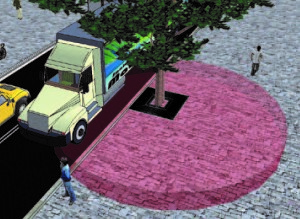Trees need appropriate amounts of loose, moist, well aerated, and uncompacted soil in order to mature in the urban environment. These conditions enable the tree’s roots to obtain nutrients, oxygen, and water – all essential for healthy tree growth. After defining in detail the soil requirements needed for healthy root growth in last week’s post, we will now discuss how much uncompacted soil trees need to thrive and reach maturity.
In addition to the nutrients that trees obtain from soil through their roots, they also need oxygen and water that occupy the voids between soil particles. These voids are abundant in uncompacted soil, however, soil in urban areas is usually compacted to provide structural integrity for paved surfaces – making void space between soil particles nonexistent.
“Trees in urban areas are frequently observed either failing in the face of hostile growing conditions, or surviving and causing damage to pavement”
If soil alone is depended on as a structural material and required for the load-bearing of buildings, vehicles, and pedestrians; it will be compacted to the point that air and water are excluded and a totally insufficient space for root growth will be available.
Trees planted in unsuitable urban tree pits are usually surrounded by compacted soil which often leads to the roots seeking out the space between the compacted soil and the paved surface above, where air and water are present. This then causes pavement heaving. If tree roots can’t grow into surrounding soil, they continue to grow until they have filled the space that’s available.
When a tree’s need for nutrients, water, and air can no longer be met, the health of the tree suffers and the tree begins to decline and eventually die. Trees grown in these conditions hardly ever reach maturity and do not provide the many benefits that healthy trees offer.
“The availability of space for tree roots to develop is crucial to a tree’s health. A growing tree’s roots will extend far into the surrounding soil to more than twice the diameter of the mature tree’s canopy”
So, how much uncompacted soil do trees need to be healthy and reach maturity? Various methods of determining required soil volume may be used to calculate the approximate below ground space that a tree should need for healthy root growth.
Mature Canopy Method
Likely the simplest method of calculating soil volume, is estimating the projected mature tree canopy diameter and multiply it by a depth of 2ft. GreenBlue offer a tree pit soil calculator that will easily provide these calculations for you.
As a general rule:
- Allow 32ft for canopy development for large trees
- Allow 20ft for canopy development for medium trees
- Allow 10ft for screens, shelter belts, or park group plantings
- Allow a minimum of 8ft in any instance
 Target Uncompacted Soil Volume = Projected Mature Canopy Diameter x 2ft (0.6m)
Target Uncompacted Soil Volume = Projected Mature Canopy Diameter x 2ft (0.6m)
Mature Trunk Caliper Method
Trunk diameter is another predictor of root spread. For young trees less than about 8″ in diameter, the ratio of root radius to trunk diameter has been found to be around 38:1 – therefore a 6″ diameter tree at maturity could have a root system extending nearly 20ft from the trunk.
Suggested Soil Volumes
Minimum recommended soil volumes are:
Small Tree: 5-15 cubic meters
Medium Tree: 20-40 cubic meters
Large Tree: 50 cubic meters
So how do we maximize uncompacted soil volume available for root growth without jeopardizing a stable base for sidewalks and roads? Soil support cells assemble underground to form a structural matrix filled with uncompacted soil to accommodate healthy root growth, while also providing a load-bearing structure for paved surfaces. They are the proven method for street trees, successfully implemented on thousands of projects around the world.
By understanding the soil conditions that urban trees need to reach maturity, landscape architects and related professionals can take the required steps in specifying the systems and best practice procedures that will ensure the success of our urban tree canopies.

